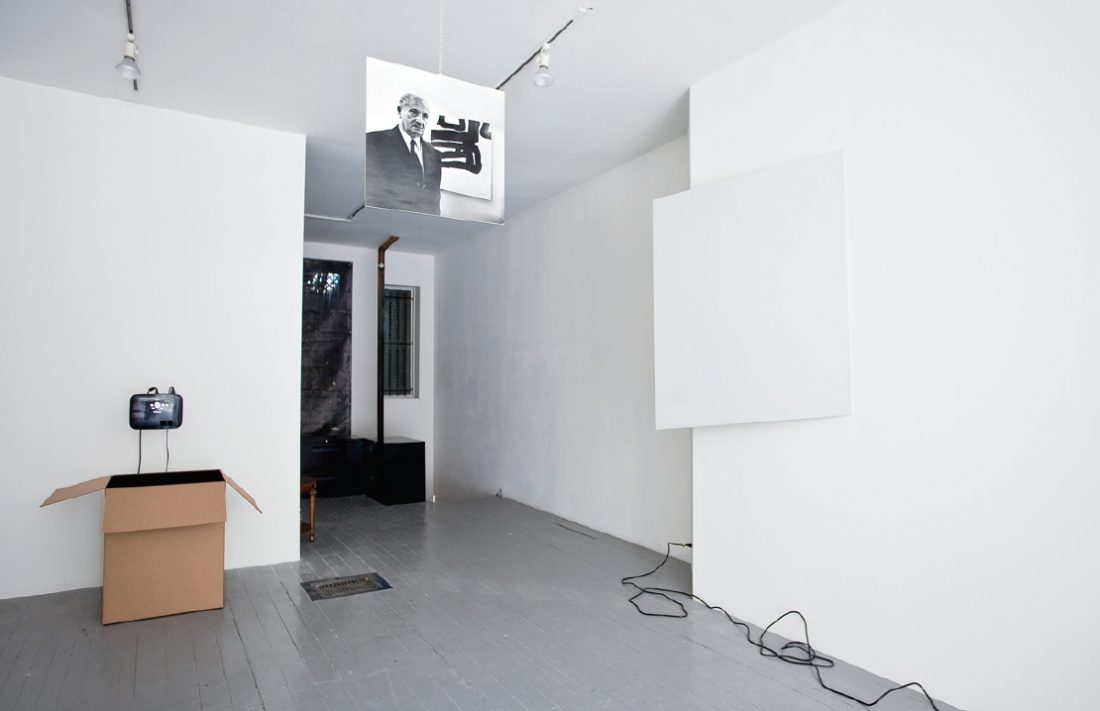“The Fox”
Art making is always, in some way, an arena for subtle thought experiments. If everyday certainties fall away and audiences are left to re-think what they thought they knew, the experiment is a success. It is a commitment to the activity of thought, as opposed to its ossification in “knowledge,” that drives artist Kevin Rodgers’s curation of “The Fox.”
Setting the stage for the performance of thought, Rodgers quotes Hannah Arendt from her book The Life of the Mind, 1978. She warns not to “mistake the need to think with the urge to know.” Thinking, Rodgers’ notes, can be bottomless. The art gallery provides an apt metaphor for the concept of a bottomless space or, in Arendtian terms, an interval in time between past and future. Rodgers’s curation fulfills this ambition primarily by being more successfully enigmatic than your average art exhibition.
The figures of Arendt and her one-time lover Martin Heidegger frame the exhibition. Giants of 20th-century thought, their romantic liaison stands in contrast to key aspects of their respective philosophical positions. Heidegger, the eponymous fox, pulled the thread of his thinking through the holes provided by the meaning of certain words, such as “being,” which are central to the edifice of language. Parsing meaning into ever greater depths of subtlety led the German philosopher, in Arendt’s view, into a trap that suggests reasons why he could disavow culpability for his association with National Socialism.

Installation views of “The Fox.” Images courtesy of the G Gallery, Guelph.
Today Arendt’s thought enjoys ruddy health, in part due to her glamorous theorization of the public sphere as a realm of authentic living. In the exhibition, Rodgers presents the two figures in poster format. A scaled-up portrait of Heidegger is hung close to the ceiling so that he casts a dour gaze down onto the exhibition. As in his philosophical writing, Heidegger exists as a remote presence. For its companion piece, the artist prints a poster of Arendt’s parable about a fox in his lair, who is happily cunning but probably amoral as a result. Thinking about the trap of your own presuppositions offers a potential for release from it by mere dint of thinking about it. By the same token, historical figures presented in visual form can only stand at the threshold of the ideas they represent. Onus for elaboration of those ideas is a job for the viewer.
The idea of an interval is given literal form by Yam Lau’s A-fold-in-two, in memory of Gordon Lebredt, 2011. Lau’s work is a reprise of a collaboration he made with Lebredt for the now defunct Toronto space, Cold City Gallery in 1997. Lebredt died of cancer earlier this year. Originally accompanying Lebredt’s series of architectural interventions at Cold City, Lau here presents two off-white metallic slabs hung high up on the wall across the room from each other. Both slabs are bent at a right angle at one end, so they slant out from the wall. Implying sightlines that slice the room in two, Lau’s work, at the same time, brackets the gallery inside the legacy of contemporary art’s rhetoric of forms.
German artist Oskar Hüber takes a different approach to the encapsulation of space. Gute Nacht! 2011, presents a luscious, tightly framed video of the moon turning on its axis, hidden at the bottom of a cardboard box. By virtue of this simple spatial manoeuvre, a whole world is contained for the benefit of our mastery. Looking down at the work, however, also has the effect of relativizing our own place on the planet. Like David Bowie says, “It’s lonely out in space.” Hüber creates an effective portrait of the limits of our world.

Installation views of “The Fox.” Images courtesy of the G Gallery, Guelph.
Belgian artist Sophie Nys presents a large-scale reproduction of the cover of Heidegger’s Die Kunst und der Raum, 1969, which hangs from the ceiling, and a video shot in the German countryside that features a still photograph of the philosopher standing in front of his summer hut. Without delving into the content of the book, its title alone, which translates as Art and Space, makes for a nice précis of the exhibition as a whole: art plus life equals the steps we take to negotiate the interval between them.
In his book about photography, Camera Lucida, 1980, Roland Barthes formulates the concept of the punctum. Derived from the Latin word for wound, punctum can mean the tiny opening the eye has for the tear duct. In Barthes’s terms, it means the part of the photograph that punctures you, bringing on unexpected emotional associations that may be unrelated to the meaning of the picture as a whole. Although not a show about photography, “The Fox” has a punctum in it: specifically, a rustic toilet seat once used by Heidegger that Nys reportedly spirited away from the philosopher’s summer retreat in the Black Forest.
Making reference to the punctum to talk about artworks is to misapply Barthes’s concept. And yet to say I am pierced by the presence of this particular toilet seat in the show is accurate. Like a pebble thrown into a pond, the implications ripple outwards. For one, it invites unwelcome thoughts about the German philosopher’s ass and its related functions. Elevating the discussion a bit, the toilet seat also prompts thoughts about real things and their relationship to art. The toilet seat is a real thing, and yet its effect depends on the story that comes with it. Nys’s piece is a powerful example of the type of experience the art gallery is uniquely capable of creating. An interval in Arendt’s sense of the term, it offers the viewer a chance to participate in a thought experiment of the truest kind. ❚
“The Fox” was exhibited at the G Gallery, Toronto, from July 14 to August 20, 2011.
Rosemary Heather is a freelance writer and curator.

